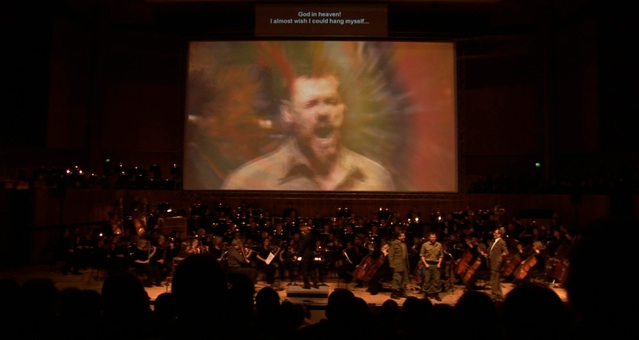Wozzeck
Presentation of the Semi-staged Visual Version

“To some, the Earth is hot as Hell, Hell’s cold next to it” (Wozzeck to the Captain)
Image Auditive, a project founded more than 12 years ago now, is investigating the interaction between image and music in traditional as well as in new artistic forms. This means conceiving and designing image as an interpretation of music, originating from the analysis of the musical score and developing it visually. The ‘unstageable’ visual fantasy of Ravel’s L’enfant et les sortilèges, the mystical synaesthesia of Messiaen’s Saint-François d’Assise, the colouristic sensuality of Saariaho’s L’amour de loin, have been interesting experiences in this endeavour, and Wozzeck is a new challenge in our exploration of the visual richness of operatic repertoire. For us, video – enriched by constantly advancing computer processing techniques – is a particularly well-adapted and accurate means by which to experience a work as deeply concerned with subjectivity as Wozzeck.
We will never know what Georg Büchner would eventually have done with the fragments that were collected by posterity under the name Woyzeck, and out of which Berg built his own dramatic structure; but in this form the play appears in its startling modernity: these fragments are insights on Wozzeck’s inner life. Each scene pictures a new space that reflects an aspect of his interiority: the society of men, symbolised by the ruthless city, as depicted for instance by such painters as Grosz or Beckmann; the intimate space of Marie’s room, a setting we revisit obsessively throughout the opera; the humiliating space of the military dormitory; the social space of the inn; and the deathly space of the pond. Indications of the libretto are very suggestive and we have found strong interpretations of comparable atmospheres in paintings of the period in which Berg composed his opera.
Most stage productions of Wozzeck have enclosed the action in shades of grey, inspired by the powerful visions of expressionist cinema, such as The Cabinet of Doctor Caligari (1920) by Robert Wiene. This production of Wozzeck projects the opera in vivid colours, inspired by expressionist paintings. Indeed, the hallucinations and mental chaos of Wozzeck, as well as the stylistic, formal and orchestral explorations of Berg’s music, find perfect parallels in the worlds – both material and mental – explored by the paintings of Franz Marc, August Macke, Wassily Kandinsky, Paul Klee and other painters of the Blaue Reiter (a German art movement of the early 1900s, named after a painting by Kandinsky, and fundamental to Expressionism). We attempt to recreate visually with today’s means the intensity Wozzeck had for the Viennese audience when it was premièred in 1925, in the middle of this artistic effervescence.
Our use here of video aims to be fully expressionistic. Indeed, it allows all sorts of distortion and creative explorations of image, as well as insight on Wozzeck’s subjectivity and descent into clinical madness, as Büchner first intended and depicted it, with the precision of the doctor’s son that he was. Among other sources, we may process live images transmitted by a micro-camera placed on singer Simon Keenlyside to quite literally share Wozzeck’s vision, in combination with the external vantage points of three other cameras. In expressionistic aesthetics, inside is outside, and visa versa. The staging takes place in front of the orchestra, in the limited, oppressive area between the musicians and the audience, trapping the singers in this flat space, forcing them to move as though on a razor’s edge. Conceived as part of the live video work, this staging is intended to allow the lavishness both of Berg’s score and of Büchner’s social drama to flow.
This opera enables us to share the vision of Wozzeck, to identify with a man nobody would want to identify with: a man too weak to object to oppression and humiliation, destroyed and driven mad by all who have any kind of power over him, including the woman he loves, who is tragically the only person he can fight back. By sharing this man’s hallucinations we cannot help wondering: do we share his delusions; what is misery – a given fact, or a process; do we unwittingly create it all around us everyday; is it somehow contagious? Probably nothing in Büchner’s or Berg’s society, or in our own, is less obvious, detectable, palpable than these processes, and Wozzeck himself is constantly looking for an appropriate expression for them, without being able to find it. But art makes the invisible visible, especially for the expressionist Alban Berg.
Jean-Baptiste & Aleksi Barrière
